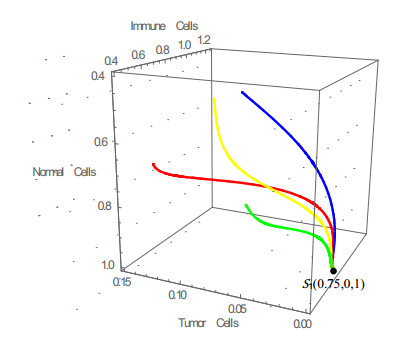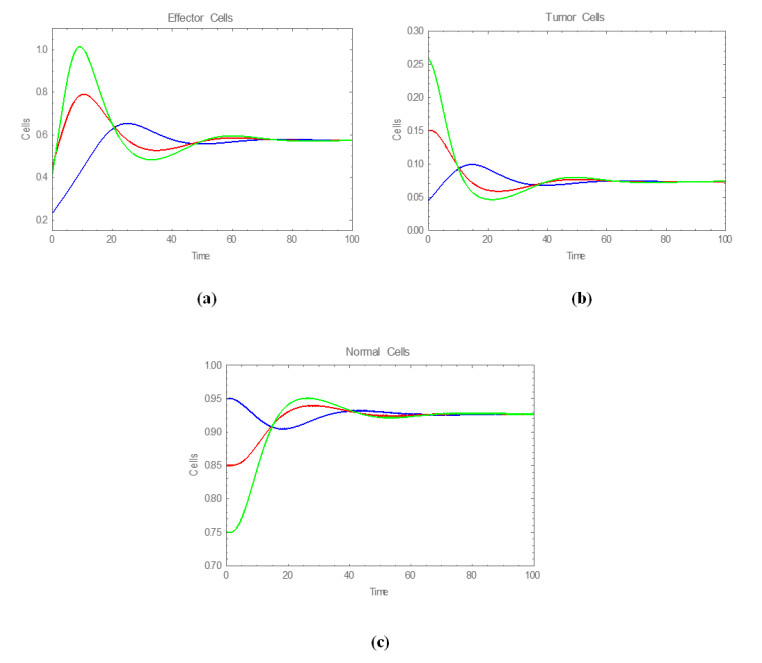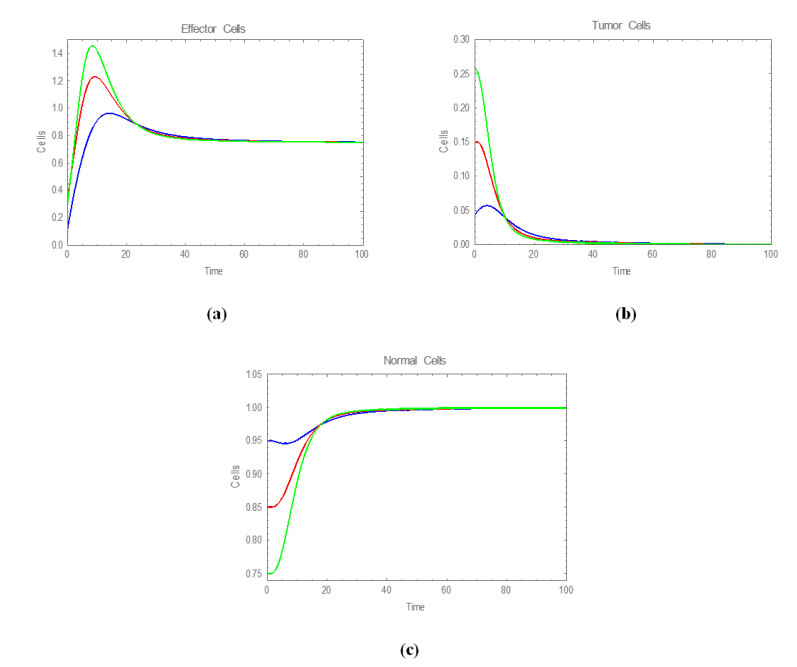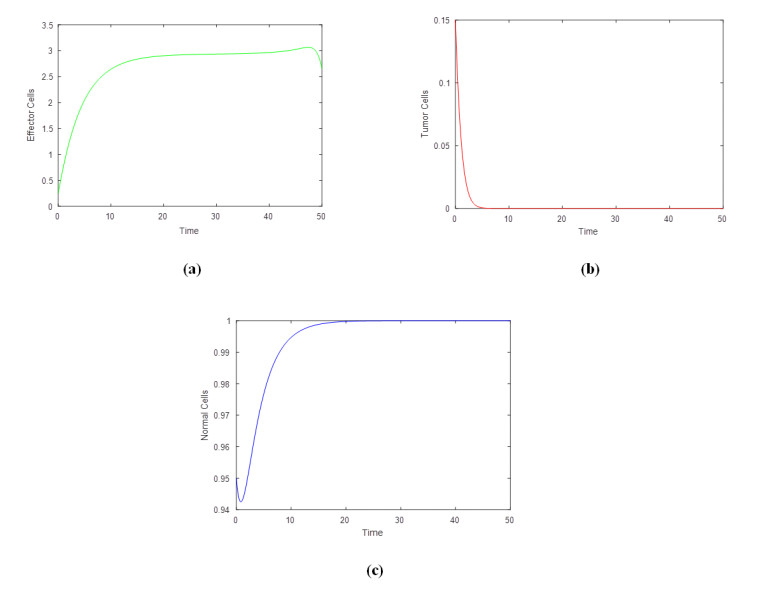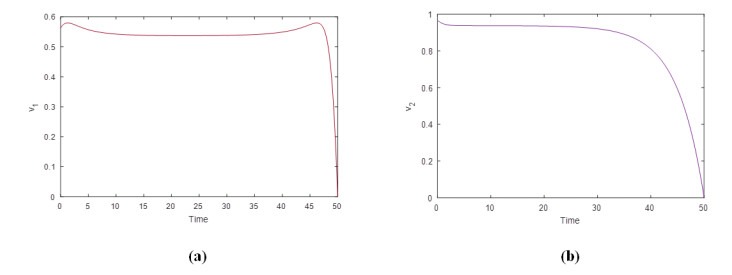1.
Introduction
Fractional differential equations (FDEs) have a profound physical background and rich theoretical connotations and have been particularly eye-catching in recent years. Fractional order differential equations refer to equations that contain fractional derivatives or integrals. Currently, fractional derivatives and integrals have a wide range of applications in many disciplines such as physics, biology, and chemistry, etc. For more information see [1,2,3,45].
Langevin equation is an important tool of many areas such as mathematical physics, protein dynamics [6], deuteron-cluster dynamics, and described anomalous diffusion [7]. In 1908, Langevin established first the Langevin equation with a view to describe the advancement of physical phenomena in fluctuating conditions [8]. Some evolution processes are characterized by the fact that they change of state abruptly at certain moments of time. These perturbations are short-term in comparison with the duration of the processes. So, the Langevin equations are a suitable tool to describe such problems. Besides the intensive improvement of fractional derivatives, the Langevin (FDEs) have been presented in 1990 by Mainardi and Pironi [9], which was trailed by numerous works interested in some properties of solutions like existence and uniqueness for Langevin FDEs [10,11,12,13,14,15,16,17,18,19]. We also refer here to some recent works that deal with a qualitative analysis of such problems, including the generalized Hilfer operator, see [20,21,22,23,24]. Recent works related to our work were done by [25,26,27,28,29,30]. The monotone iterative technique is one of the important techniques used to obtain explicit solutions for some differential equations. For more details about the monotone iterative technique, we refer the reader to the classical monographs [31,32].
Lakshmikantham and Vatsala [25] studied the general existence and uniqueness results for the following FDE
by the monotone iterative technique and comparison principle. Fazli et al. [26] investigated the existence of extremal solutions of a nonlinear Langevin FDE described as follows
via a constructive technique that produces monotone sequences that converge to the extremal solutions. Wang et al. [27], used the monotone iterative method to prove the existence of extremal solutions for the following nonlinear Langevin FDE
Motivated by the novel advancements of the Langevin equation and its applications, also by the above argumentations, in this work, we apply the monotone iterative method to investigate the lower and upper explicit monotone iterative sequences that converge to the extremal solution of a fractional Langevin equation (FLE) with multi-point sub-strip boundary conditions described by
where HDμ1,β1;ϕ0+ and HDμ2,β2;ϕ0+ are the ϕ-Hilfer fractional derivatives of order μ1∈(0,1] and μ2∈(1,2] respectively, and type β1,β2∈[0,1],σi>0,λ1,λ2∈R+, δi>0, m≥1, 0<ζ1<ζ2<......<1, f:(0,b]×R→R is a given continuous function and ϕ is an increasing function, having a continuous derivative ϕ′ on (0,b) such that ϕ′(ϰ)≠0, for all ϰ∈(0,b]. Our main contributions to this work are as follows:
∙ By adopting the same techniques used in [26,27], we derive the formula of explicit solutions for ϕ-Hilfer-FLEs (1.1) involving two parameters Mittag-Leffler functions.
∙ We use the monotone iterative method to study the extremal of solutions of ϕ-Hilfer-FLE (1.1).
∙ We investigate the lower and upper explicit monotone iterative sequences that converge to the extremal solution.
∙ The proposed problem (1.1) covers some problems involving many classical fractional derivative operators, for different values of function ϕ and parameter μi,i=1,2. For instance:
∙ If ϕ(ϰ)=ϰ and μi=1, then the FLE (1.1) reduces to Caputo-type FLE.
∙ If ϕ(ϰ)=ϰ and μi=0, then the FLE (1.1) reduces to Riemann-Liouville-type FLE.
∙ If μi=0, then the FLE (1.1) reduces to FLE with the ϕ-Riemann-Liouville fractional derivative.
∙ If ϕ(ϰ)=ϰ, then the FLE (1.1) reduces to classical Hilfer-type FLE.
∙ If ϕ(ϰ)=logϰ, then the FLE (1.1) reduces to Hilfer-Hadamard-type FLE.
∙ If ϕ(ϰ)=ϰρ, then the FLE (1.1) reduces to Katugampola-type FLE.
∙ The results obtained in this work includes the results of Fazli et al. [26], Wang et al. [27] and cover many problems which do not study yet.
The structure of our paper is as follows: In the second section, we present some notations, auxiliary lemmas and some basic definitions which are used throughout the paper. Moreover, we derive the formula of the explicit solution for FLE (1.1) in the term of Mittag-Leffler with two parameters. In the third section, we discuss the existence of extremal solutions to our FLE (1.1) and prove lower and upper explicit monotone iterative sequences which converge to the extremal solution. In the fourth section, we provide a numerical example to illustrate the validity of our results. The concluding remarks will be given in the last section.
2.
Auxiliary notions
To achieve our main purpose, we present here some definitions and basic auxiliary results that are required throughout our paper. Let J:=[0,b], and C(J) be the Banach space of continuous functions υ:J→R equipped with the norm ‖υ‖=sup{|υ(ϰ)|:ϰ∈J}.
Definition 2.1. [2] Let f be an integrable function and μ>0. Also, let ϕ be an increasing and positive monotone function on (0,b), having a continuous derivative ϕ′ on (0,b) such that ϕ′(ϰ)≠0, for all ϰ∈J. Then the ϕ-Riemann-Liouville fractional integral of f of order μ is defined by
Definition 2.2. [33] Let n−1<μ<n, (n∈N), and f,ϕ∈Cn(J) such that ϕ′(ϰ) is continuous and satisfying ϕ′(ϰ)≠0 for all ϰ∈J. Then the left-sided ϕ-Hilfer fractional derivative of a function f of order μ and type β∈[0,1] is defined by
where
Lemma 2.3. [2,33] Let n−1<μ<n, 0≤β≤1, and n<δ∈R. For a given function f:J→R, we have
and
Lemma 2.4. [33] Let f:J→R, n−1<μ<n, and 0≤β≤1. Then
(1) If f∈Cn−1(J), then
(2) If f∈C(J), then
Lemma 2.5. For μ,β,γ>0 and λ∈R, we have
where Eγ,β is Mittag-Leffler function with two-parameterdefined by
Proof. See [34].
Lemma 2.6. [27] Let μ∈(1,2] and β>0 be arbitrary. Then the functions Eμ(⋅), Eμ,μ(⋅) and Eμ,β(⋅) are nonnegative. Furthermore,
for χ<0.
Lemma 2.7. Let μ,k,β>0, λ∈R and f∈C(J). Then
Proof. See [34].
For some analysis techniques, we will suffice with indication to the classical Banach contraction principle (see [35]).
To transform the ϕ-Hilfer type FLE (1.1) into a fixed point problem, we will present the following Lemma.
Lemma 2.8. Let γj=μj+jβj−μjβj, (j=1,2) such that μ1∈(0,1],μ2∈(1,2], βj∈[0,1],λ1,λ2≥0 and ℏ is a functionin the space C(J). Then, υ is a solutionof the ϕ-Hilfer linear FLE of the form
if and only if υ satisfies the following equation
where
Proof. Let (HDμ2,β2;ϕ0++λ2)υ(ϰ)=P(ϰ). Then, the problem (2.1) is equivalent to the following problem
Applying the operator Iμ1,ϕ0+ to both sides of the first equation of (2.4) and using Lemma 2.4, we obtain
where c0 is an arbitrary constant. For explicit solutions of Eq (2.4), we use the method of successive approximations, that is
and
By Definition 2.1 and Lemma 2.3 along with Eq (2.6), we obtain
Similarly, by using Eqs (2.6)–(2.8), we get
Repeating this process, we get Pk(ϰ) as
Taking the limit k→∞, we obtain the expression for Pk(ϰ), that is
Changing the summation index in the last expression, i→i+1, we have
From the definition of Mittag-Leffler function, we get
By the condition P(0)=0, we get c0=0 and hence
Equation (2.9) reduces to
Similarly, the following equation
is equivalent to
By the condition υ(0)=0, we obtain c2=0 and hence Eq (2.11) reduces to
By the condition υ(b)=∑mi=1δi Iσi,ϕ0+υ(ζi), we get
Put c0 in Eq (2.12), we obtain
Substituting Eq (2.10a) into Eq (2.14), we can get Eq (2.2).
On the other hand, we assume that the solution υ satisfies Eq (2.2). Then, one can get υ(0)=0. Applying HDμ2,β2;ϕ0+ on both sides of Eq (2.2), we get
Since γ2=μ2+β2−μ2β2, then, by Lemma 2.3, we have HDμ2,β2;ϕ0+[ϕ(ϰ)−ϕ(0)]γ2−1=0 and hence Eq (2.15) reduces to the following equation
By using some properties of Mittag-Leffler function and taking ϰ=0, we obtain
Thus, the derivative condition is satisfied. The proof of Lemma 2.8 is completed.
Lemma 2.9. (Comparison Theorem). For j=1,2, let γj=μj+jβj−μjβj, μ1∈(0,1],μ2∈(1,2], βj∈[0,1],λ1≥0 and υ∈C(J) be acontinuous function satisfies
then υ(ϰ)≥0, ϰ∈(0,b].
Proof. If z≥0, then from Lemma 2.6, we have Eμ,β(z)≥0. If z<0, then Eμ,β(z) is completely monotonic function [35], that means Eμ,β(z) possesses derivatives for all arbitrary integer order and (−1)ndndznEμ,β(z)≥0. Hence, Eμ,β(z)≥0 for all z∈R. In view of Eq (2.2), Eq (2.9), and from fact that Eμ1,γ1(⋅)≥0 and Eμ,μ(⋅)≥0 with help the definition of ϕ, we obtain υ(ϰ)≥0, for ϰ∈(0,b]. (Alternative proof). Let (HDμ2,β2;ϕ0++λ2)υ(ϰ)=P(ϰ). Then, we have
Assume that P(ϰ)≥0 (for all ϰ∈(0,b]) is not true. Then, there exist ϰ1,ϰ2, (0<ϰ1<ϰ2≤b) such that P(ϰ2)<0,P(ϰ1)=0 and
Since λ1≥0, we have (HDμ1,β1;ϕ0++λ1)P(ϰ)≥0 for all ϰ∈(ϰ1,ϰ2). In view of
the operator I1−γ1;ϕ0+P(ϰ) is nondecreasing on (ϰ1,ϰ2). Hence
On the other hand, for all ϰ∈(ϰ1,ϰ2), we have
which is a contradiction. Therefore, P(ϰ)≥0 (ϰ∈(0,b]). By the same technique, one can prove that υ(ϰ)≥0, for all ϰ∈(0,b].
As a result of Lemma 2.8, we have the following Lemma.
Lemma 2.10. For j=1,2, let γj=μj+jβj−μjβj, μ1∈(0,1],μ2∈(1,2], βj∈[0,1] and f:J×R→R is continuous function . If υ∈C(J) satisfies the problem (1.1), then, υ satisfies thefollowing integral equation
3.
Existence of extremal solutions
In this part, we focus on the existence of lower and upper explicit monotone iterative sequences that converge to the extremal solution for the nonlinear ϕ-Hilfer FLE (1.1). The existence of unique solution for the problem (1.1) is based on Banach fixed point theorem. Now, let us give the following definitions:
Definition 3.1. For J= [0,b]⊂R+. Let υ∈C(J). Then, the upper and lower-control functions are defined by
and
respectively. Clearly, ¯f(ϰ,υ(ϰ)) and f_(ϰ,υ(ϰ)) are monotonous non-decreasing on [a,b] and
Definition 3.2. Let ¯υ, υ_ ∈C(J) be upper and lower solutions of the problem (1.1) respectively. Then
and
According to Lemma 2.8, we have
and
Theorem 3.3. Let ¯υ(ϰ) and υ_(ϰ) be upper and lower solutions of the problem (1.1), respectively such that υ_ (ϰ)≤¯υ(ϰ) on J. Moreover, the function f(ϰ,υ) is continuouson J and there exists a constant number κ>0 such that |f(ϰ,υ)−f(ϰ,v)|≤κ|υ−v|, for υ,v∈R+, ϰ∈J. If
then the problem (1.1) has a unique solution υ∈C(J).
Proof. Let Ξ=P−P_, where P(ϰ)=(HDμ2,β2;ϕ0++λ2)υ(ϰ) and P_(ϰ)=(HDμ2,β2;ϕ0++λ2)υ_(ϰ). Then, we get
In view of Lemma 2.9, we have Ξ(ϰ)≥0 on J and hence P_ (ϰ)≤P(ϰ). Since P(ϰ)=(HDμ2,β2;ϕ0++λ2)υ(ϰ) and P_(ϰ)=(HDμ2,β2;ϕ0++λ2)υ_(ϰ), by the same technique, we get υ_ (ϰ)≤υ(ϰ). Similarly, we can show that υ(ϰ)≤¯υ(ϰ). Consider the continuous operator G:C(J)→C(J) defined by
Clearly, the fixed point of G is a solution to problem (1.1). Define a closed ball BR as
with
where
and P=sups∈J|f(s,0)|. Let υ∈BR and ϰ∈J. Then by Lemma 2.6, we have
Now, we will present the proof in two steps:
First step: We will show that G(BR)⊂BR. First, by Lemma 2.6 and Definition 2.1, we have
Next, for υ∈BR, we obtain
Thus G(BR)⊂BR.
Second step: We shall prove that G is contraction. Let υ,ˆυ∈BR and ϰ∈J. Then by Lemma 2.6 and Definition 2.1, we obtain
Thus, G is a contraction. Hence, the Banach contraction principle theorem [35] shows that the problem (1.1) has a unique solution.
Theorem 3.4. Assume that ¯υ,υ_∈C(J) be upper and lower solutions of the problem (1.1), respectively, and υ_ (ϰ)≤¯υ(ϰ) on J. Inaddition, If the continuous function f: J×R→R satisfies f(ϰ,υ(ϰ))≤f(ϰ,y(ϰ)) for allυ_ (ϰ)≤υ(ϰ)≤y(ϰ)≤¯υ(ϰ),ϰ∈ J then there exist monotoneiterative sequences {υ_j}∞j=0 and {¯υj}∞j=0 which uniformly converges on J to the extremal solutions of problem (1.1) in Φ={υ∈C(J):υ_(ϰ)≤υ(ϰ)≤¯υ(ϰ),ϰ∈J}.
Proof. Step (1): Setting υ_0=υ_ and ¯υ0=¯υ, then given {υ_j}∞j=0 and {¯υj}∞j=0 inductively define υ_j+1 and ¯υj+1 to be the unique solutions of the following problem
and
By Theorem 3.3, we know that the above problems have a unique solutions in C(J).
Step (2): Now, for ϰ∈J, we claim that
To confirm this claim, from (3.1) for j=0, we have
With reference to the definitions of the lower solution υ_(ϰ)=υ_0(ϰ) and putting Ξ(ϰ)=P1(ϰ)− P_ 0(ϰ), where P1(ϰ)=(HDμ2,β2;ϕ0++λ2)υ1(ϰ) and P_0(ϰ)=(HDμ2,β2;ϕ0++λ2)υ_0(ϰ). Then, we get
Consequently, Lemma 2.9 implies Ξ(ϰ)≥0, that means P_ 0(ϰ)≤P1(ϰ),ϰ∈J and by the same technique, where P(ϰ)=(HDμ2,β2;ϕ0++λ2)υ(ϰ) we get υ(ϰ)≥0. Hence, υ_0(ϰ)≤υ_1(ϰ),ϰ∈J. Now, from Eq (3.4) and our assumptions, we infer that
Therefore, υ_1 is a lower solution of problem (1.1). In the same way of the above argument, we conclude that υ_1(ϰ)≤υ_2(ϰ),ϰ∈J. By mathematical induction, we get υ_j(ϰ)≤υ_j+1(ϰ),ϰ∈J,j≥2.
Similarly, we put Ξ(ϰ)=¯P1(ϰ)−P_1(ϰ), where ¯P1(ϰ)=(HDμ2,β2;ϕ0++λ2)¯υ1(ϰ) and P_1(ϰ)=(HDμ2,β2;ϕ0++λ2)υ_1(ϰ). Then, we get
Consequently, Lemma 2.9 implies Ξ(ϰ)≥0, that means ¯P1(ϰ)≤P_1(ϰ),ϰ∈J and by the same technique, we get ¯υ1(ϰ)≥υ_1(ϰ),ϰ∈J. By mathematical induction, we get ¯υj(ϰ)≥υ_j(ϰ), ϰ∈J, j≥0.
Step (3): In view of Eq (3.3), one can show that the sequences {υ_j}∞j=0 and {¯υj}∞j=0 are equicontinuous and uniformly bounded. In view of Arzela-Ascoli Theorem, we have limj→∞υ_j=υ∗ and limj→∞¯υj=υ∗ uniformly on J and the limit of the solutions υ∗ and υ∗ satisfy the problem (1.1). Moreover, υ∗, υ∗∈Φ.
Step (4): We will prove that υ∗ and υ∗ are the extremal solutions of the problem (1.1) in Φ. For this end, let υ∈Φ be a solution of the problem (1.1) such that ¯υj(ϰ)≥υ(ϰ)≥υ_j(ϰ),ϰ∈J, for some j∈N. Therefore, by our assumption, we find that
Hence
and
Consequently, ¯υj+1(ϰ)≥υ(ϰ)≥υ_j+1(ϰ),ϰ∈J. It follows that
Taking the limit of Eq (3.5) as j→∞, we get υ∗(ϰ)≥υ(ϰ)≥υ∗(ϰ), ϰ∈J. That is, υ∗ and υ∗ are the extremal solutions of the problem (1.1) in Φ.
Corollary 3.5. Assume that f:J×R+→R+ is continuous, and there exist \bmℵ1,\bmℵ2>0 such that
Then the problem (1.1) has at least one solution υ(ϰ)∈C(J). Moreover
and
Proof. From Eq (3.6) and definition of control functions, we get
Now, we consider the following problem
In view of Lemma 2.8, the problem (3.10) has a solution
Taking into account Eq (3.9), we obtain
It is obvious that ¯υ(ϰ) is the upper solution of problem (1.1). Also, we consider the following problem
In view of Lemma 2.8, the problem (3.11) has a solution
Taking into account Eq (3.9), we obtain
Thus, υ_(ϰ) is the lower solution of problem (1.1).
The application of Theorem 3.4 results that problem (1.1) has at least one solution υ(ϰ)∈C(J) that satisfies the inequalities (3.7) and (3.8).
4.
An example
Example 4.1. Let us consider the following problem
Here μ1=12,μ2=32,β1=β2=13,γ1=23,γ2=43,λ1=λ2=10,m=1,δ1=14,σ1=23,ζ1=34,b=1, ϕ=eϰ,λ1=λ2=10 and we set f(ϰ,υ(ϰ))=2+ϰ2+ϰ35(1+υ(ϰ))υ(ϰ). For υ,w∈R+, ϰ∈J, we have
By the given data, we get Q1≈0.9<1 and hence all conditions in Theorem 3.3 are satisfied with κ=15>0. Thus, the problem (4.1) has a unique solution υ∈C(J). On the other hand, from Theorem 3.4 and Theorem 3.3, the sequences {υ_n}∞n=0 and {¯υn}∞n=0 can be obtained as
and
Moreover, for any υ∈R+ and ϰ∈[0,1], we have
It follows that
Thus, by Corollary 3.5, we get \bmℵ1=2 and \bmℵ2=165. Then by Definitions 3.1 and 3.2, the problem (4.1) has a solution which verifies υ_ (ϰ)≤υ(ϰ)≤¯υ(ϰ) where
and
are respectively the upper and lower solutions of the problem (4.1) and
Let us see graphically, we plot in Figure 1 the behavior of the upper solution ¯υ and lower solution υ_ of the problem (4.1) with given data above.
5.
Conclusions
In this work, we have proved successfully the monotone iterative method is an effective method to study FLEs in the frame of ϕ-Hilfer fractional derivative with multi-point boundary conditions. Firstly, the formula of explicit solution of ϕ-Hilfer type FLE (1.1) in the term of Mittag-Leffler function has been derived. Next, we have investigated the lower and upper explicit monotone iterative sequences and proved that converge to the extremal solution of boundary value problems with multi-point boundary conditions. Finally, a numerical example has been given in order to illustrate the validity of our results.
Furthermore, it will be very important to study the present problem in this article regarding the Mittag-Leffler power low [36], the generalized Mittag-Leffler power low with another function [37,38], and the fractal-fractional operators [39].
Acknowledgments
Researchers would like to thank the Deanship of Scientific Research, Qassim University for funding the publication of this project. The authors are also grateful to the anonymous referees for suggestions that have improved manuscript.
Conflict of interest
The authors declare that they have no competing interests.
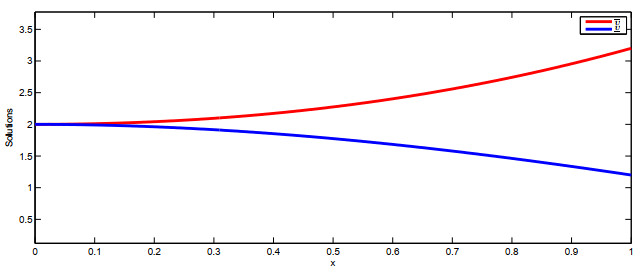









 DownLoad:
DownLoad:


